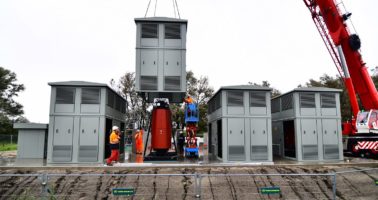The Municipality of Rotterdam and the Port of Rotterdam Authority are working together on the joint rollout of shore-based power for sea-going vessels in Rotterdam. By 2030, they want a significant share of sea-going vessels to 'plug in' once they have moored along one of the port's quays. This will allow them to power down their diesel generators while berthed - good news for local air quality and the vessels' carbon footprint. Over the next five years, the partners will be initiating a series of projects that are intended to accelerate and scale up the adoption of shore-based power. Depending on the experiences gained in these projects, the Municipality and the Port Authority may adapt their targets in this area in 2025.
According to Arno Bonte, Deputy Mayor of Rotterdam for Sustainability, Clean Air and Energy Transition, the plan is a big step forward for the port's sustainability. Shore power allows us to connect ships to a clean energy source. This prevents both air pollution and noise nuisance - which will improve conditions for local residents and the surrounding natural areas. "Our port will once again be a little greener."
"Our vision combines ambition and pragmatism. We will establish eight to ten onshore power projects for a variety of types of maritime vessels. We will do this in partnership with companies in the port area and with the shipping companies that use our port. We will continually monitor the results of these projects to know if we can speed up the process or need to take a little more time.
Allard Castelein, CEO of the Port of Rotterdam Authority
Ships
Ships require electrical power for a variety of processes on board, such as lighting, operating all kinds of equipment, and keeping containers with food products at the right temperature, for example. This energy generally comes from diesel generators, which release pollutants, carbon emissions, and noise. In principle, a ship could also be connected to the shore power grid while docked. However, this requires that the ship itself, the terminal docks and the electrical network adapt to this solution.
Every year, seagoing vessels anchored in Rotterdam docks consume as much electrical energy as 250,000 to 300,000 households. And in the process, they release various harmful emissions into the atmosphere, including 600,000 tons of CO2 and 8,000 tons of nitrogen. By 2030, the Rotterdam strategy on the coast could result in carbon savings of approximately 200,000 tonnes per year.
In recent years, practically all public docks for inland navigation in Rotterdam have been equipped with a shore power socket. Inland waterway vessels consume much less energy than their seagoing counterparts. To limit disturbance to the surrounding area, the Stena Line ferry at Hoek van Holland has been using ground power for some time. And Eneco and the Port Authority are currently working on an onshore power facility near Rozenburg for the Heerema offshore vessels, which regularly dock at this location.
Three pillars
In view of the variety of ship types and berths involved, the partners have based their onshore strategy on three different pillars. The first pillar focuses primarily on the quality of the surrounding social environment, ensuring that all public docks in built-up areas are ultimately equipped with shore power outlets. The goal is for 90% of these connections to be used by ships calling at the port by 2030. In addition, Rotterdam is also examining opportunities for onshore powering along private docks near the areas. urbanized.
The second pillar is characterized by "big steps forward wherever possible." The aim is to build new onshore power capacity for ferries, ro-ro ships, oceangoing vessels and cruise ships, which should have a utilization rate of 90% by 2030. For container ships, the ambition has been set on a 50% adoption of shore power by large ships (10,000+ TEU) from 2030. And finally, the third pillar focuses on the development of innovations for special categories of ships such as, for example , liquid bulk carriers, which are difficult to accommodate with current shore-based power facilities.
In the coming years, the goal is to carry out eight to ten concrete projects on land, which will be divided among the three main pillars of the program. This program is expected to require a total investment of around 125 million euros. Most of this budget will be provided by the companies involved, the City Council and the Port Authority. However, around 50 million euros will have to be covered by public funding.

